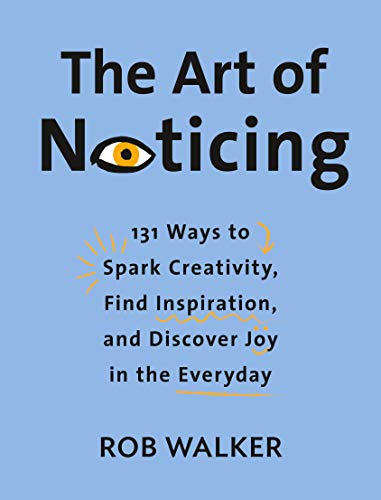These books on creativity offer ways business leaders can support creativity, innovation, and talent in the new future of work
- Big Little Breakthroughs by Josh Linkner (2020) for unleashing creative potential in yourself and your team
- Softening the Edge by Mimi Nicklin (2020) for insights on leading with awareness, empathy, and compassion
- The Art of Noticing by Rob Walker (2019) for replenishing your creativity and discovering new insights
Big Little Breakthroughs: How Small, Everyday Innovations Drive Oversized Results
By Josh Linkner
Big Little Breakthroughs is the latest book by Josh Linkner, a serial entrepreneurial innovator and angel investor. He describes Big Little Breakthroughs as “Small creative acts that unlock massive rewards over time. They are the sparks that fuse into a raging fire. Sometimes microscopic and invisible to the naked eye, they are the molecules that bind together to solve our trickiest problems and unlock our biggest opportunities.”
He debunks the myth that the best ideas are fleeting flashes of creative genius, only bestowed upon the Einsteins of the world. He argues that innovation rarely happens in a blinding flash of inspiration: “Big Little Breakthroughs in the aggregate, drive far more progress than their elusive change-the-world counterparts.”
Instead of waiting for a flash of genius to strike at any moment, Linkner says the most effective innovators develop habits that foster imagination, innovative thinking, and creativity. Pattern recognition and divergent thinking skills are much more impactful on creativity than flashes of brilliance. Creativity is a learned skill, not a magical power, and Linkner shows you how in this book.
What I like about his book is the abundance of inspiring stories about how real people in diverse situations find breakthrough ideas, as well as field-tested tools and techniques to try on your own or with your team. While I am familiar with many of the tools and techniques featured in the book, I like Linkner’s perspectives. His stories give context to the activities, and I now have some new insights into helping my own clients unlock their creativity.
Linkner reveals the techniques of highly creative people such as Lady Gaga, Steven Spielberg and Bansky to decode their habits and borrow from their approaches. He also takes you behind the scenes of a high-tech chemistry lab in Santa Barbara, a punk rock concert in Berlin, a greasy burger joint in Manhattan, a disaster-relief effort in Nepal, a Zealand yacht racing team, and even a Texas prison. In other words, not the usual suspects. That’s what makes this book so engaging.
Check out this book to discover:
- Popular myths about creativity and what the research actually shows about our creative capacity;
- How a 5% “Creativity Upgrade” can drive meaningful results in our careers and communities;
- The basic components of a successful idea and how to use them to spark our own;
- Why we should ditch pervasive cliches like “if it ain’t broke, don’t fix it” to revamp old mindsets;
- Techniques and activities that exercise our creative muscles;
- Stories of everyday people who achieved huge success by unleashing their creative potential.
Big Little Breakthroughs is available on Amazon
Softening the Edge: Empathy: How humanity’s oldest leadership trait is changing our world
By Mimi Nicklin
This book is a cri de coeur about making a conscientious and empathetic change to your career or business. Mimi Nicklin, an advertising executive based in Dubai says, “Empathetic influence is this decade’s most critical human and scientifically validated skillset. The ability to connect authentically as people has the power to not only change our business environments, but to change the shape of our world.”
Softening the Edge focuses on something I have been passionate about for my entire career—the sustainable wellness of our workforce, treating people with kindness and decency, and the future of effective leadership that sustainably promotes human values as well as the financial value of every business. It addresses the Global Empathy Deficit from within our organizations, based on my own experiences leading teams around the world, and inspired by the turnaround story in my current organization. The book focuses on the point where humanism and capitalism meet and is a passionate propagator of my own ‘principles of people’ that I practice every day. The goal is to create a wider understanding that the world of leadership and business is critically responsible for playing a role in protecting and improving our social future. Especially post the crisis that together we are currently recovering from. We now see a future that demands more social cohesion and connectedness within our organizations than ever before.
The most compelling part of the book for me is Nicklin’s story of how she inherited a deeply troubled, fearful and unhappy team from a previous boss. She describes how she built trust, created cohesion, and fostered a culture grounded in empathy, respect and human connection rather than fear – and how she led her team through a business turnaround from disfunction at every level; toward being one of the fastest-growing agency teams in Dubai, winning landmark clients.
She writes, “The whole experience eventually proved to me that empathy does bring joy and contentedness and that these emotions, when rippled across a team with a clear strategy, builds business, competitive edge, and profit. Faster than one would expect.”
Interspersed with her personal story, Nicklin offers timely advice on:
- The impact of empathy on a struggling business
- How to harness your emotional intelligence to connect with employees on a deeper level
- How empathy can be used to increase retention in an organization
- Why we need an empathetic leader during a crisis (like COVID-19)
- The connection between empathy & mental health
- How to increase empathy in the workplace
- Stress and the power of self-empathy
- How to cope when you don’t have empathetic leadership
- The science of empathy & why being empathetic works
Softening the Edge is available on Amazon.
The Art of Noticing: 131 Ways to Spark Creativity, Find Inspiration, and Discover Joy in the Everyday
By Rob Walker
Through the simple practice of observing, it is possible to experience new insights, creative ideas, and moments of joy—and that’s what The Art of Noticing is all about. This book provides the antidote we all need to counter the negative effects our electronic devices have on us in terms of interfering with our sleep, memory, attention spans, creativity, problem-solving and productivity.
Walker has a charming writing style, and he provides a wide variety of fun activities to awaken your senses and spark your creativity. These include:
Look Slowly. Discover the Big Within the Small. Sketch a Room You Just Left. Follow the Quiet. Review the Everyday. Hunt the Infrathin. Get There the Hard Way. Eat Somewhere Dubious. Trespass. Make a Field Guide. Talk To a Stranger. Listen to an Elder. Be Alone in Public. Make a Personal Map. Interview An Object. Care for Something.
Walker writes: “To stay eager, to connect, to find interest in the every day, to notice what everybody else overlooks — these are vital skills and noble goals. They speak between looking and seeing, between hearing and listening, between accepting what the world presents and noticing what matters to you.”
I have tried several of Walker’s activities to expand moments of delight and curiosity during a grim pandemic. I like the simplicity of his activities and have used some in my workshops as well. To be a good creator or innovator, you must be a good observer, and that means noticing things no one else has.
The Art of Noticing is Available on Amazon








